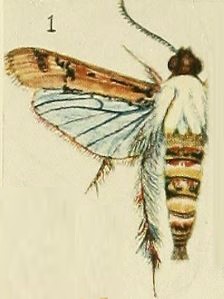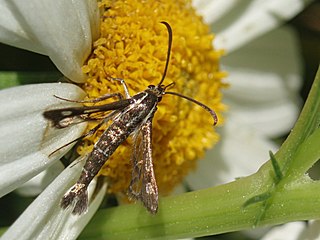
The Sesiidae or clearwing moths are a diurnal moth family in the order Lepidoptera known for their Batesian mimicry in both appearance and behaviour of various Hymenoptera.

Pseudosesia oberthuri, the golden clearwing, is a moth of the family Sesiidae. It is found in the northern part of Australia.
Nokona carulifera is a moth of the family Sesiidae. It is only known from Kuranda in Queensland, but probably occurs throughout the western coastal regions of Queensland.
Nokona coracodes is a moth of the family Sesiidae. It is only known from Toowoomba, Queensland.
Pseudosesia isozona is a moth of the family Sesiidae. It is found in Queensland, Australia.
Pseudosesia zoniota is a moth of the family Sesiidae. It is known only from the female holotype which was collected near the Claudie River on the Cape York Peninsula in Queensland, Australia.
Melittia chalybescens is a moth of the family Sesiidae. It is known only from Queensland, where it was collected near Kuranda and Mackay.
Ichneumenoptera chrysophanes, the clearwing persimmon borer, is a moth of the family Sesiidae. It is found from Cairns in Queensland to Canberra in the Australian Capital Territory.
Ichneumenoptera commoni is a moth of the family Sesiidae which was described by W. Donald Duckworth and Thomas Drake Eichlin in 1974. It is known only from the male type which was collected near Toowoomba in Queensland, Australia.
Ichneumenoptera xanthogyna is a moth of the family Sesiidae. It is known only from locations near Kuranda in Queensland, Australia.
Synanthedon cupreifascia is a moth of the family Sesiidae. It is known only from locations near Mackay in Queensland.

Melittia is a genus of moths in the family Sesiidae.
Stenosphecia is a monotypic genus of moths in the family Sesiidae. Its sole species is Stenosphecia columbica. Both genus and species were described in 1917 by Ferdinand Le Cerf. It is found in the Neotropical realm.

Melittia gloriosa, the glorious squash vine borer or manroot borer, is a moth of the family Sesiidae. It is known from North America, including Arizona, California, New Mexico, Oklahoma and Texas.

Melittia snowii is a moth of the family Sesiidae. It is known from the United States, including Arizona.

Pyropteron muscaeforme, the thrift clearwing, is a moth of the family Sesiidae. It is known from most of Europe. A small member of its genus, the wingspan is 15–18 mm. It is further distinguished by narrow clear (transparent) spaces on the blackish, or bronzy, forewings. There are three whitish bands on the body, and traces of a whitish line along the middle of the back.

Synanthedon formicaeformis, the red-tipped clearwing, is a moth of the family Sesiidae and can be found in all of Europe, the eastern Palearctic realm, and the Near East. The larvae sometimes form pear-shaped galls on willows. It was first described by Eugenius Johann Christoph Esper in 1783.
Synanthedon flaviventris, the sallow clearwing, is a moth of the family Sesiidae. The larvae form pear-shaped galls on sallows.
This page is based on this
Wikipedia article Text is available under the
CC BY-SA 4.0 license; additional terms may apply.
Images, videos and audio are available under their respective licenses.





